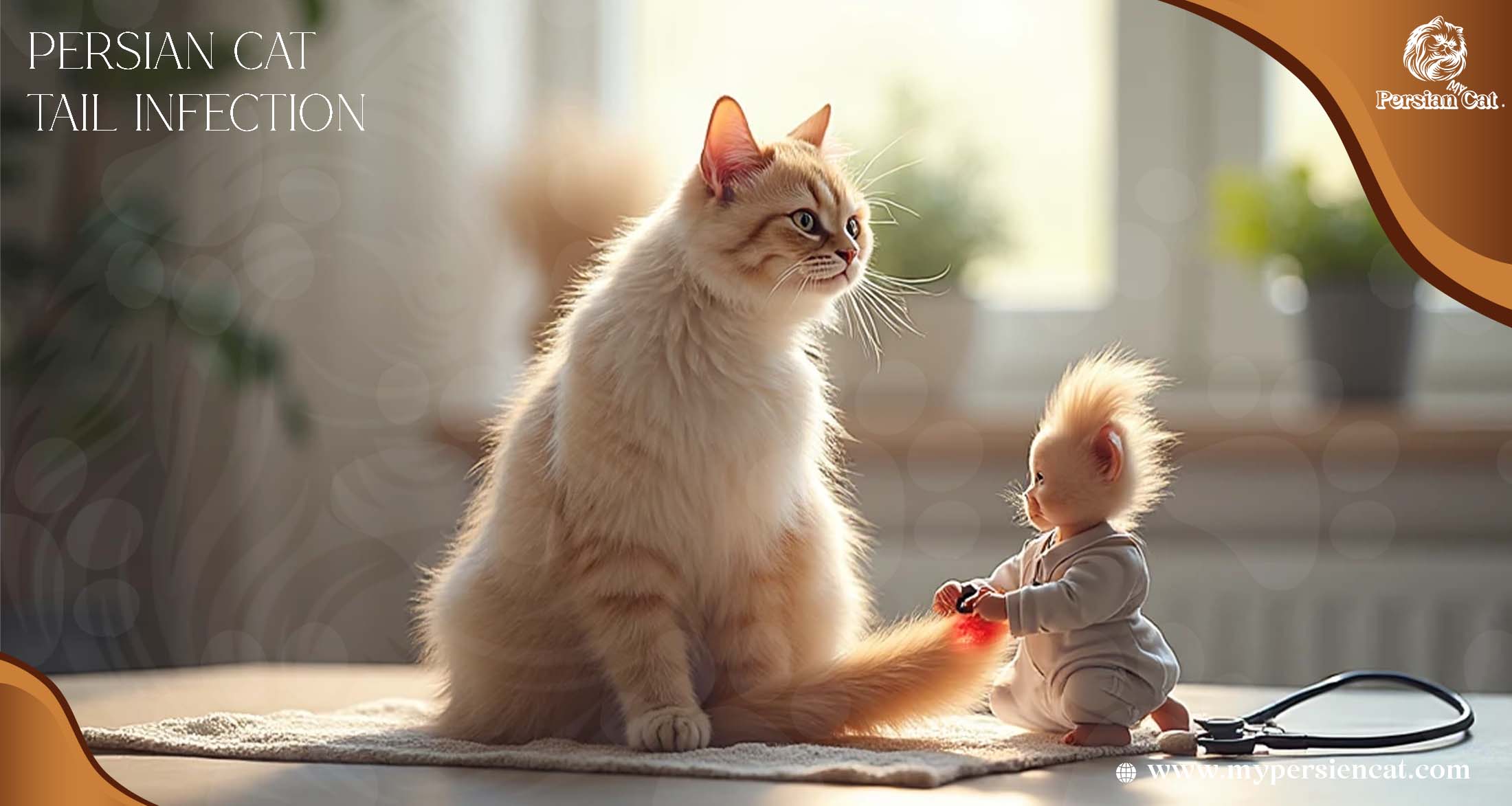Introduction
I still remember the first time I saw a Persian cat with a tail infection. At first, it looked like a small greasy patch. Soon, it turned into a sore wound that needed vet care. Many cat parents think these signs are minor. But tail problems in Persians and Himalayans can be more serious.
Some issues are simple, like stud tail. Others are worse, like a cat broken tail or even a bad feline injury. As someone who has lived through pet adoption, grooming stress, and late-night vet visits, I know how scary it can feel.
In this guide, I’ll share what I’ve learned. We’ll look at signs, causes, treatments, and easy steps you can try at home. If you’ve ever asked, “Can a cat’s tail heal on its own?” or “How do you treat a Persian cat infection?”—you’re in the right place.
What Is a Persian Cat Tail Infection?
A Persian cat tail infection happens when the skin around the tail gets sore, oily, or hurt, and germs move in. Some people call it “tail disease,” but that can mean many things. In simple words, it is any problem that makes the tail red, swollen, or unhealthy.
For Persian and Himalayan cats, the most common cause is stud tail. This happens when a gland at the base of the tail makes too much oil. The extra grease clumps the fur, pulls in dirt, and can lead to infection. If not treated, it may also cause blackheads, hair loss, or even a yeast infection.
But oil is not the only cause. A fungal infection can also spread to the tail, mostly if the coat stays wet or dirty. Injuries are another big risk. A broken tail, sprain, or even a small cut can let in bacteria. Once germs enter, the area may swell, leak fluid, or become very painful.
In my work with rescue cats, I’ve seen both mild and severe cases. One looked like only a greasy patch. Another was a serious tail injury that needed vet care. That is why I always tell new cat parents—never ignore tail problems, no matter how small they look.
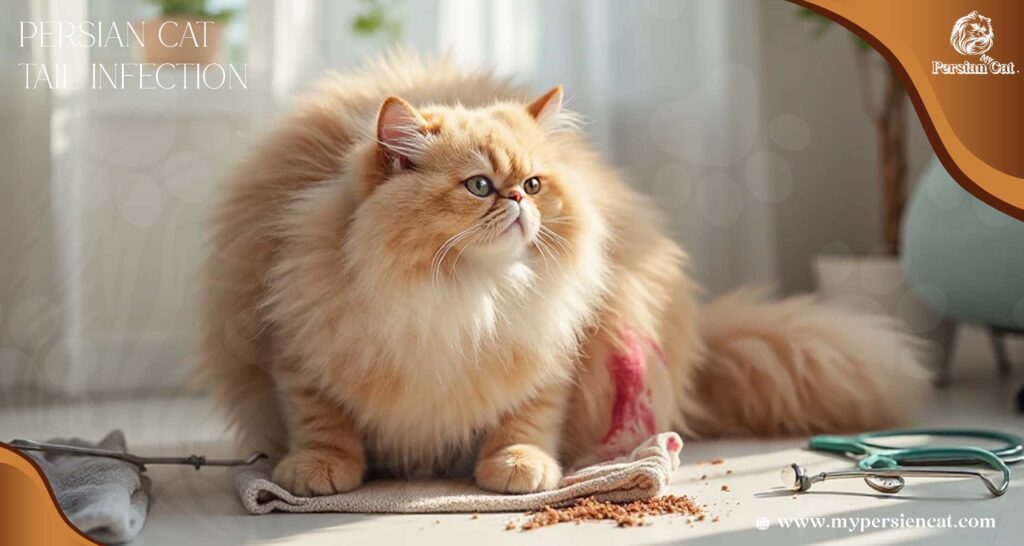
Signs and Symptoms to Watch For
The first time I saw a Persian cat tail infection, I thought it was just a greasy patch. But within days, the fur clumped up, and a strong smell showed up. Tail problems in cats are sneaky. They start small but can get worse fast if you ignore them.
Here are the most common signs to watch for:
- Greasy or oily fur at the tail base – This is often the first clue of stud tail. The oil makes the coat look dirty, even after grooming.
- Strong odor – A tail infection or yeast infection can cause a smell you won’t forget. If you notice it, act fast.
- Redness, swelling, or pus – These are clear signs of infection. The skin gets sore, and pus may leak out.
- Blackheads, flakes, or bald spots – Cats can get clogged pores too. On the tail, they look like tiny dots or flakes that lead to hair loss.
- Chewing, licking, or rubbing the tail – A cat in pain will fuss over the area. If your Persian or Himalayan won’t leave its tail alone, it may be a warning.
In my rescue work, I cared for a cat who kept licking his tail. At first, I thought it was normal grooming. But soon, I saw bald spots and small sores. That day, I learned not to ignore even small signs of pain. Cats hide discomfort until it gets serious.
Think of your cat’s tail as a health flag. When it’s fluffy, shiny, and clean, your pet is doing well. When it looks greasy, swollen, or sore, it’s a warning that something is wrong.
Common Causes of Persian Cat Tail Infections
When I first worked with rescue cats, I thought tail infections only came from poor grooming. But I soon learned there are many causes. Some are simple. Others are more serious. Knowing them helps you spot trouble early and protect your pet.
Stud Tail
This is the most common cause in long-haired breeds. You may wonder, “what is stud tail?” It’s when a gland at the base of the tail makes too much oil. The extra oil clumps the fur, traps dirt, and can lead to infection. Even neutered cats can get it, though males have it more often. I once cared for a cat with stud tail who needed medicated shampoo for weeks.
Fungal Infections
A fungal infection spreads fast when the coat stays damp. Persians and Himalayans, with their thick coats, are at higher risk. Fungus makes the tail patchy, itchy, and sore. It’s like athlete’s foot, but in cats—and it won’t clear up on its own.
Yeast Infections
Too much oil can also cause yeast to grow. A yeast infection on the tail often comes with greasy fur, redness, and a strong smell. I call it the “warning smell.” Once you notice it, the infection has already begun.
Injuries
Sometimes the cause is trauma, not oil or fungus. A broken, sprained, or dislocated tail can let in bacteria. I’ve seen a small cut on a cat’s tail turn into a big infection. Even small wounds can get serious fast.
Poor Grooming or Hygiene
Persians are beautiful, but their coats need daily care. If the tail isn’t brushed and cleaned, dirt and oil build up. That makes the perfect spot for infection. Families with kids should be careful too—playful pulling or rough handling can add to the problem.
Each cause is different, but the result is the same: a cat in pain. Think of it like a chain reaction. Oil, dirt, or injury set the stage, and infection takes over if you don’t act fast.
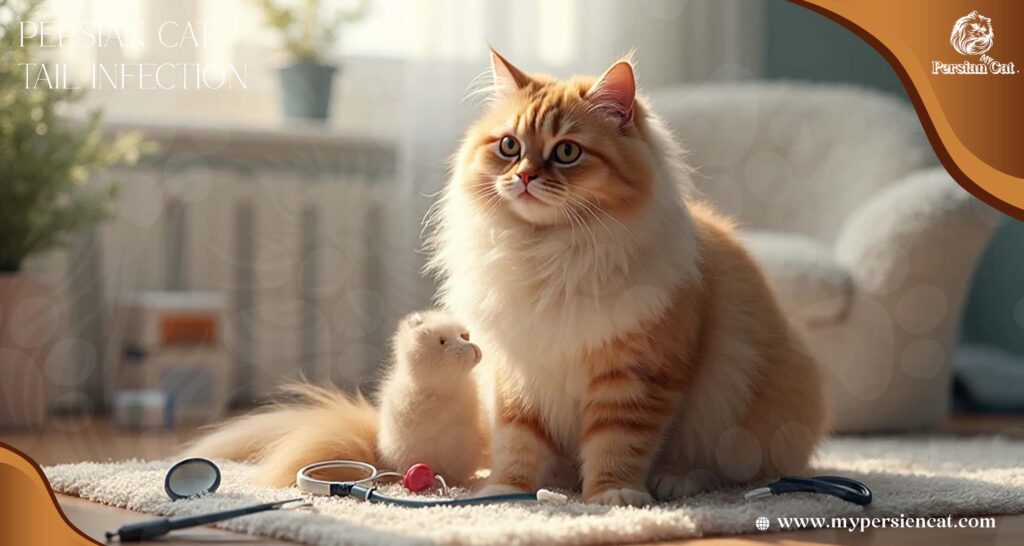
Diagnosis: How Vets Identify Tail Infections
When I first saw a Persian cat tail infection, I thought I could fix it at home. The greasy patch, the smell, the bald spots—I tried brushing and cleaning. But within days, it got worse. That’s when I learned an important lesson: only a vet can find the real cause of a sick tail.
Vets don’t just look and guess. They start with a close exam. They check for redness, swelling, or oily buildup. In many cases, they use Persian cat tail infection pictures or stud tail cat pictures to explain what’s wrong. It’s like using a health chart. It clears up doubt and gives answers.
If the case looks tricky, the vet may take skin scrapings or samples. These go under a microscope to check for fungus or yeast. Sometimes they run a cytology test or a culture. This helps spot hidden bacteria. It matters because treatment for stud tail is not the same as treatment for a broken or sprained tail.
Trying to diagnose at home is risky. I once thought a greasy tail was just stud tail. But it turned out to be a small broken tail injury that was getting infected. Without the vet’s test, I would have missed it. That mistake could have harmed my rescue cat.
If you are unsure, think of the vet as a safety net. The visit saves stress, protects your cat’s comfort, and makes sure the right treatment is used. Most infections heal well once the cause is clear. And for new cat parents, that peace of mind is worth far more than guessing.
How Do You Treat a Persian Cat Infection? (Treatment Options)
When I first faced a Persian cat tail infection, I felt stuck. Should I clean it at home? Wait and see? Or rush to the vet? If you’ve asked, “How do you treat a Persian cat infection?”—you’re not alone. The good news is most infections can be treated. The right care depends on the cause.
Vet-Approved Treatments
Most vets start with medicated shampoos or wipes. These help clear grease, especially in stud tail cats. If the infection is fungal or yeast-based, antifungal creams or oral meds are needed. For a cat yeast infection or fungal infection, this step is a must. Home cleaning won’t cure it. If bacteria are to blame, antibiotics are given. Think of it as using the right tool for each kind of wound.
Tail Injuries and Serious Cases
If your cat has a broken, sprained, or dislocated tail, the treatment is different. Sometimes a bandage is enough. In severe cases—like when the tail bone shows—surgery may be needed. I once cared for a rescue cat with a dislocated tail. It healed only after weeks of vet care and rest. That taught me tail injuries are never “just minor.”
Neutering to Reduce Stud Tail
If your male Persian has recurring stud tail, neutering can help. After surgery, the overactive glands calm down. This lowers the chance of future infections. It’s not only prevention—it’s long-term comfort.
Here’s the key: don’t guess, and don’t wait. Treatment works best when started early. With the right care, your cat can go from sore and restless back to fluffy and happy in no time.
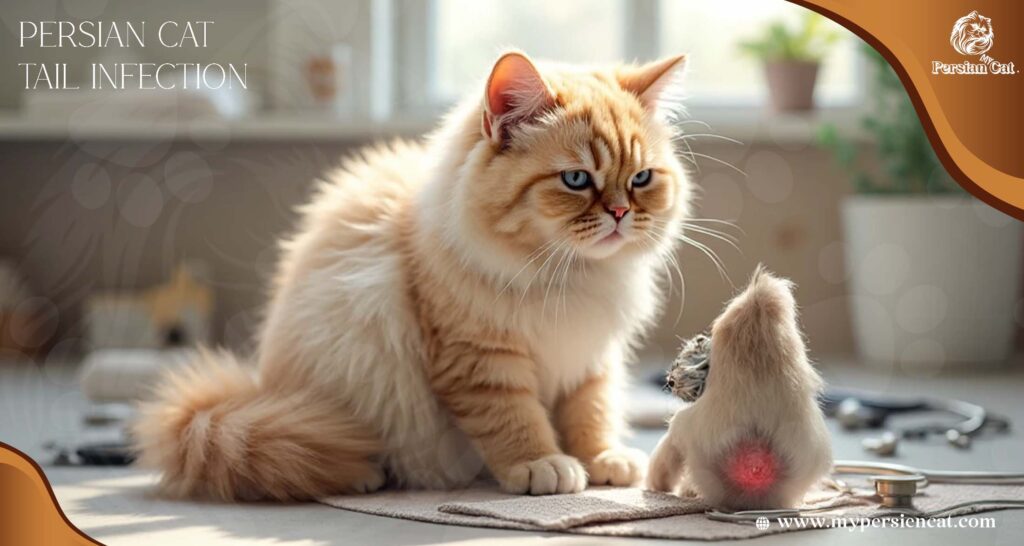
Home Remedies and Supportive Care
When I rescued a Persian with a tail problem, I felt unsure. Should I rush to the vet, or try gentle care at home? The truth is, Persian cat tail infections are tricky. Some mild cases, like early stud tail, can be eased with simple steps. But serious issues—like a fungal infection or a broken tail—always need a vet.
Gentle Cleaning
One safe step is light cleaning. Use warm water and a soft cloth to wipe away grease at the tail base. It feels like a fresh reset. In mild cases, this alone can ease discomfort and stop dirt from building up.
Trimming the Fur
Long fur on Persians and Himalayans traps oil and germs. Trimming the fur around the spot makes the skin easier to keep dry and clean. I learned this when one of my rescues kept getting yeast infections. Once I trimmed the fur, healing sped up.
Clean Bedding
Don’t forget your cat’s space. Change blankets and bedding often. I remember switching my rescue’s blanket every day during recovery. It felt like extra work, but it cut down on odor and germs. Clean, soft bedding is a simple but powerful remedy.
Know the Limits
Home care works only for mild cases. If you see swelling, pus, or a strong smell, don’t wait. I once thought I could heal a small cut with cleaning alone. By the time I got vet help, it had turned into a deep wound. That taught me not to risk it.
Think of home care like helping with a scratch, not surgery. You can clean, comfort, and prevent. But when things look serious, only the vet is safe. With love, quick action, and good planning, your Persian can heal and stay fluffy—even after tail troubles.
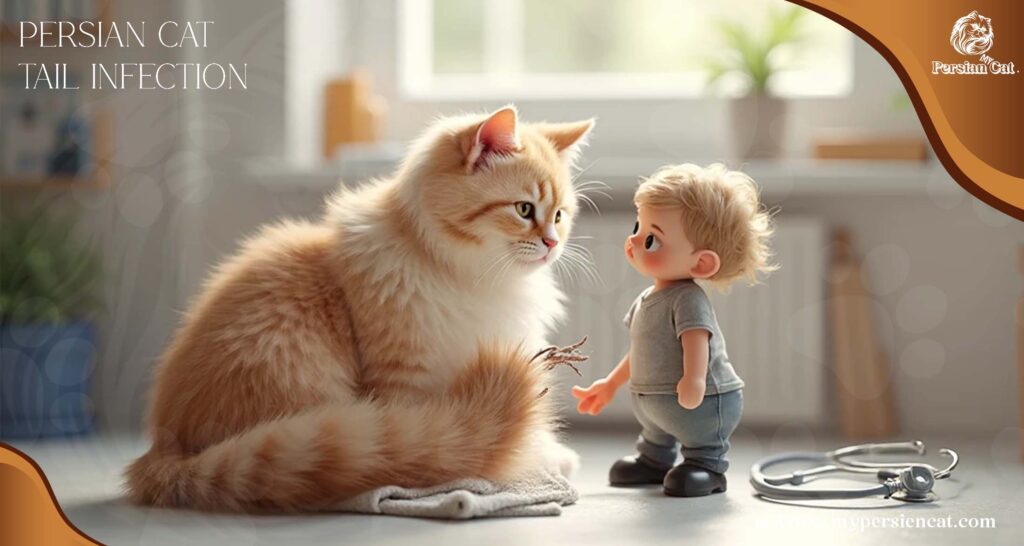
Can a Cat’s Tail Heal on Its Own?
This is one of the most common questions new cat parents ask. I remember asking it myself when I adopted a rescue Persian with a sore tail. I hoped the wound would heal on its own, like a scratch on human skin. But with a Persian cat tail infection, it’s rarely that simple.
Small scratches or light swelling may heal if the area stays clean. Cats are strong healers, and sometimes nature does the work. But for a tail injury—like a broken tail, sprained tail, or dislocated tail—healing without care is unlikely. Just like a sprained ankle in people, the pain lasts and the damage can get worse if ignored.
I once cared for a rescue with what looked like a tiny wound near the tail base. At first, it seemed harmless. But within days, it turned into a full infection. That was my lesson: infections spread fast, especially in long-haired cats like Persians and Himalayans. Waiting too long can turn a small issue into a serious problem.
Think of it this way: your cat’s tail is more than fluff. It helps with balance, shows emotions, and is part of their personality. When it gets hurt, cats can’t always heal alone. With quick vet care and good support at home, most cats recover well and go back to wagging their tails with comfort and ease.
Prevention Tips for Persian Cat Owners
When it comes to Persian cat tail infection, prevention is better than cure. I learned this the hard way with my first rescue. One missed step in grooming or bedding led to a painful infection. After that, I promised myself to stay alert.
Regular Grooming
Daily brushing near the tail base is a must. Long-haired cats like Persians and Himalayans trap oil, dirt, and mats fast. Even a quick comb keeps clumps away. Think of it as a mini spa for your cat—simple, fun, and healthy.
Scheduled Vet Visits
Vet visits aren’t just for shots. A checkup can catch early signs of stud tail, yeast, or fungus before they spread. I aim for two visits a year, more if the cat is older or has a thick coat.
Spaying or Neutering
For male Persians, neutering lowers the risk of stud tail. The glands calm down, oil drops, and infection is less likely. It’s like fixing the problem at the root.
Clean Home and Bedding
Dirty blankets or cushions hold germs. I change bedding often and wipe down spots where my cats rest. This small step keeps tails clean and infection away.
Family and Kids
Playful pulling or rough handling can hurt a cat’s tail. I teach kids to be gentle and respect space. This helps prevent sprains, breaks, or dislocations. A little guidance goes a long way.
At the end of the day, caring for a Persian’s tail takes love and small daily efforts. With clean homes, gentle handling, and good planning, your fluffy friend will stay healthy, happy, and tail-flicking with joy.
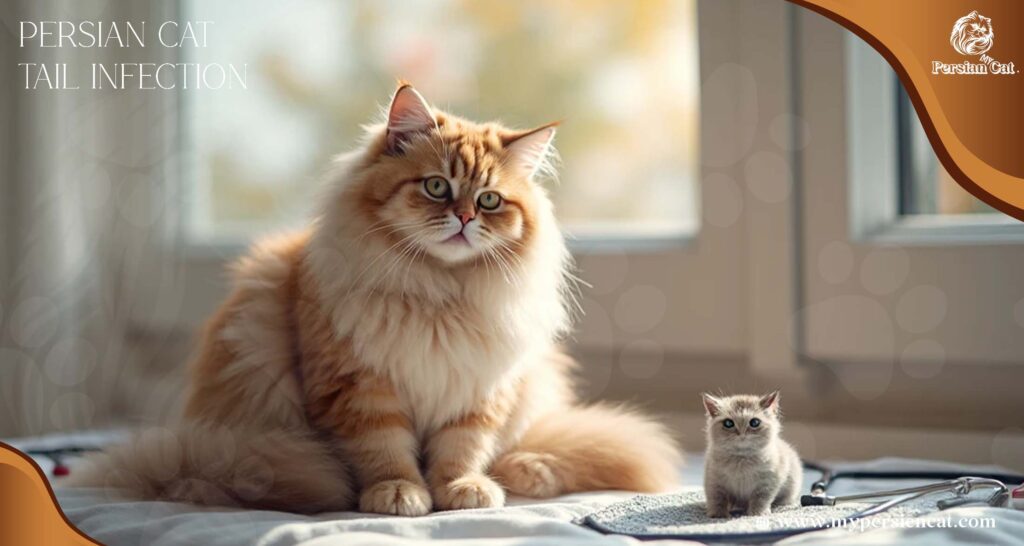
My Personal Experience With Tail Infections
I’ll never forget when I saw my rescue Persian’s tail was sore. At first, it was just a greasy patch. I thought, “Maybe this is only stud tail.” But soon I saw it was worse. The skin turned red. It looked swollen. There was even a faint bad smell. That was the day I learned how rough a Persian cat tail infection can be.
Caring for him was not easy. Grooming became a daily task. I brushed his tail base, checked for mats, and wiped the fur clean. My small flat made things harder. I even had to ask my landlord if I could keep a pet. Still, each step—trimming fur, washing bedding, and watching him close—taught me to be patient.
My kids also needed guidance. They love cats, but even soft play can hurt a tail. A quick pull can lead to a sprain or worse. I had to show them how to give space and handle our cat with care. It took time, but it worked.
This whole journey changed me. I saw that caring for a Persian or Himalayan is not just about their looks. It’s about spotting signs fast—oily fur, bald spots, or swelling. It’s about acting quick, giving love each day, and planning ahead.
Today, that same rescue cat is healthy. He is fluffy, bright-eyed, and tail-flicking with joy. For me, he is proof that care, love, and daily effort really work.
Final Thoughts: Living With and Caring for Persian Cats
Caring for a Persian cat takes time, love, and care. From my own cats, I learned one thing fast. If you act early, most tail problems heal well. A bit of brushing, fresh bedding, and daily checks go a long way. These small steps keep your cat safe and happy.
Before you bring home a Persian or rescue one, plan ahead. Think about space, daily grooming, and rules like pet permits or landlord notes. These steps may seem small, but they cut stress for you and your cat. Persians and Himalayans do best when their home is calm and full of care.
Your cat will give back so much. You’ll get love, joy, and those sweet tail flicks that show mood. But if you see red skin, swelling, or a bad smell, don’t wait. A quick vet trip can stop things from getting worse. It may be stud tail, a yeast spot, or even a small cut—but fast care makes all the difference.
Life with a Persian is a gift. Brushing, trimming fur, and checking the tail each day may feel like chores, but they guard health and build trust. With love, care, and a bit of planning, your fluffy friend will stay bright, safe, and tail-flicking with joy for years to come.
About The Author
Yasin Ahmed Tusher
I Have Five Years of Experience With Persian Cat
In that time, I have learned a lot about how to care for them. Persian cats have long, soft fur, so they need to be brushed often. I know how to brush and bathe them to keep their coats clean and smooth.
I also understand what they like to eat and how to keep them healthy. Persian cats are calm and loving. I enjoy spending time with them and making sure they feel happy and safe.
I can give them medicine if needed and watch for signs of illness. I know how to care for both kittens and older cats. Taking care of Persian cats is something I do with love and care every day.
Phone : 01978040328
Fax : 001978040328
Email : info@mypersiencat.com
Persian Cat Tail Infection Persian Cat Tail Infection Persian Cat Tail Infection Persian Cat Tail Infection Persian Cat Tail Infection Persian Cat Tail Infection Persian Cat Tail Infection Persian Cat Tail Infection Persian Cat Tail Infection Persian Cat Tail Infection
Persian Cat Tail Infection Persian Cat Tail Infection Persian Cat Tail Infection Persian Cat Tail Infection Persian Cat Tail Infection Persian Cat Tail Infection Persian Cat Tail Infection Persian Cat Tail Infection Persian Cat Tail Infection Persian Cat Tail Infection

